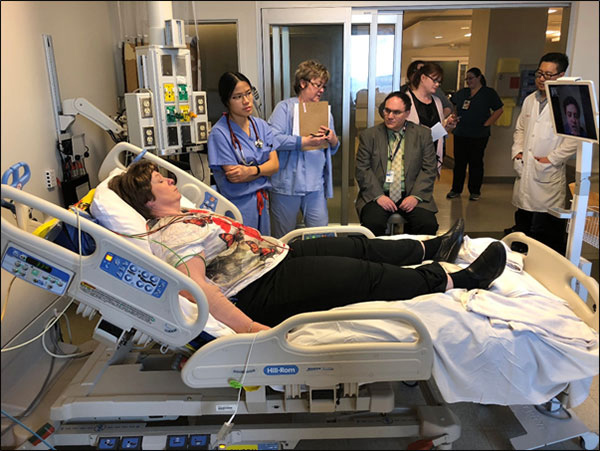 |
Evaluating National Program to Improve Access to Acute Stroke Services for Rural VeteransHSR&D’s monthly publication Veterans’ Perspectives highlights research conducted by QUERI investigators, showcasing the importance of research for Veterans – and the importance of Veterans for research. In the June 2018 Issue:
|
BackgroundFacts about stroke:Someone in the United States has a stroke every 40 seconds, and every 4 minutes someone dies of a stroke. About 87% of all strokes are ischemic strokes, in which blood flow to the brain is blocked.1 Ischemic stroke is common among Veterans, accounting for more than 6,000 admissions to VA facilities and approximately 60,000 outpatient visits for stroke-related care annually.2Prompt access to high-quality care is crucial to limiting the damage caused by stroke; long-term effects can include impaired vision or speech, severe weakness or paralysis, difficulties swallowing, memory loss, depression, and mood swings. In collaboration with VA’s Office of Rural Health, the Office of Neurology, under the direction of Glenn Graham MD, launched a National TeleStroke Program (NTSP) to improve access to acute stroke services for Veterans residing in rural communities by using mobile and telehealth technologies to bring acute stroke expertise to the bedside – anywhere in the country. Led by Dr. Sharyl Martini, NTSP Medical Director, specialty care is provided by a virtual team of stroke neurologists directly to a Veteran presenting to the emergency department of a rural VA medical center – or other VA facility without access to specialty stroke neurologists. VA facilities that partner with the NTSP have access to some of the country’s best academic stroke neurologists, enabling emergency room consultations during the critical first 60 minutes of acute stroke onset. |
VA’s National TeleStroke ProgramVA’s National TeleStroke Program was launched early in FY2018 and now has eight participating facilities. In the first and second quarter of FY2018, the NTSP conducted onsite training at seven VA facilities, with an additional 1,039 VA employees completing 3,045 web-based telestroke trainings. In the first six months of operation, 94 acute Telestroke consultations were completed. Of these, 46% were diagnosed with stroke and 11% with transient ischemic attack (TIA). More than half of the Veterans (56%) receiving a Telestroke consultation were living in rural areas, and 2% were living in highly rural areas (defined by VA as “remotest occupied land areas”). There are 5.1 million Veterans living in rural and highly rural settings, with 2.7 million enrolled in VA healthcare 3.
Red = VA facilities current participating in NTSP, Yellow = Future NTSP facilities, Green = Location of telestroke MDs Evaluating the Impact of the NTSP ProgramAn evaluation team led by Dr. Linda Williams and Ms. Holly Martin, with the QUERI national program Precision Monitoring to Transform Care (PRIS-M), is assessing the impact of the NTSP program on patient access and quality of care – and is also collecting feedback from facilities and Veterans about their level of satisfaction with this innovative service. Thus far, QUERI investigators have found that Veterans are highly satisfied with their Telestroke experience. Of the 94 receiving a Telestroke consultation, 33 could be reached by phone and could recall and report on the experience. The mean satisfaction score was 6.5 (the range was from 1 to 7, with a higher score being better). 
VA Emergency Department staff and simulation trainers participate in the Telestroke Program go-live training at the Las Vegas VA Medical Center on January 18, 2018. Veterans’ Perspective
“It felt like a personal interaction…like we were important,” and that “The Telestroke doctor seemed very knowledgeable…truly interested.” - Participating Veteran During the interviews, Veterans and their families gave much positive feedback about the National TeleStroke Program. For example, one Veteran stated that “It felt like a personal interaction…like we were important,” and that “The Telestroke doctor seemed very knowledgeable…truly interested.” Other Veteran patients and their families were impressed with the use of technology, with one Veteran describing the virtual services as “…It was like he [Telestroke doctor] was there with me, just without being able to touch me so he used the nurses to do that.” Another reported “…it was like Star Trek!” and “…my son and I were very impressed with the technology.” Other Veterans reported satisfaction with the additional medical expertise during the medical visit: “Two [doctors’] heads are better than one” and “…[it was] nice to have access to a specialist even when they are not available onsite.” Even for Veterans who were found not to have had a stroke, the Program has had impact, with one Veteran reporting that the consultation “…saved time and relieved [my] concerns. VA’s National TeleStroke Program is expanding across the VA healthcare system, with the expectation of adding at least seven additional facilities in FY2018. |
References
|